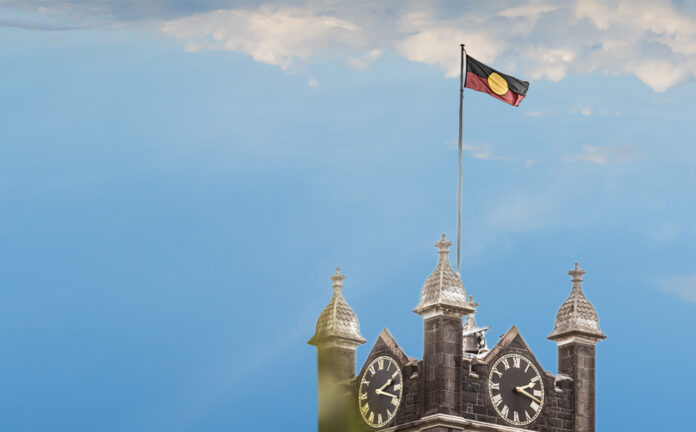On 27 May 2020, on the first day of National Reconciliation Week, TJ Bin Hitam-Keeffe and Jack Brown, Co-Chairs of the School’s Reconciliation Committee, gave meaningful speeches highlighting the need to create a better Australia for all Australians, as the Australian Aboriginal flag flew from Witherby Tower. Here are their presentations:
Jack Brown, Year 12
The Australian Aboriginal flag is a representation of all Aboriginal Australians. Within the flag designed by Harold Thomas, there is much symbolism – the black of the flag representing the Aboriginal people of Australia, the red representing the red ochre colour of the Earth and the spiritual connection to the land and the yellow circle representing the sun, the giver of life and protector.
With the raising of the flag at Melbourne Grammar on top of Witherby Tower, we are showing respect and acknowledgment of all Aboriginal Australian across Australia.
This is very important here at Melbourne Grammar, as it shows that we are united in working towards the goal of building respectful relationships between Aboriginal and Torres Strait Islander peoples and other Australians, and to create a fair and equal society. This is only one step in a positive direction towards achieving an equal and untied Australia that everyone is hopeful for.
TJ Bin Hitam-Keeffe, Year 11
Born and bred in the Kimberley region of Western Australia and belonging to the Bardi Jawi tribe, I personally pay homage to the traditional owners of the land in which I speak on today – he Wurundjeri and Bunerong people of the Kulin nation, whom have occupied and cared for this vast Victorian country for thousands of years.
2020 – a trying time for all of us amid the unfortunate circumstances that we have found ourselves in due to COVID-19. However, this year’s reconciliation theme encapsulates the essence of what we, as Australian’s, Indigenous or not must do in this time of turbulence.
‘In this together’, as the 2020 reconciliation theme, reflects that reconciliation is not an individualised approach to removing the barriers that divide our Indigenous and non-Indigenous counterparts. It takes courage, belief and understanding from all parties to move forward to come to a mutual understanding of the pain derived from the past and the existing pain and issues that are prevalent today.
Just yesterday was Sorry Day, a day to commemorate those, alive and passed, who were taken from their families aligning with a white Australian government induced policy. A policy that labelled our people as half cast and aimed to assimilate us into a white culture based on beliefs of inferiority.
To put it blandly, we are dying years earlier than our non-Indigenous counterparts; we are being killed in custody and are faced with systemic racism from the very institutions that are designed to help us.
A hard to swallow pill for mainstream Australia is realising that they are a part of these issues when they demonstrate complacency because it hurts Aboriginal and Torres-Islander people, as it would anybody, when they aren’t seen as equals, and people stand by and watch.
And to clarify – this is not a cry for sympathy, this is merely truth telling.
We can and will be better, as a nation and a community.



